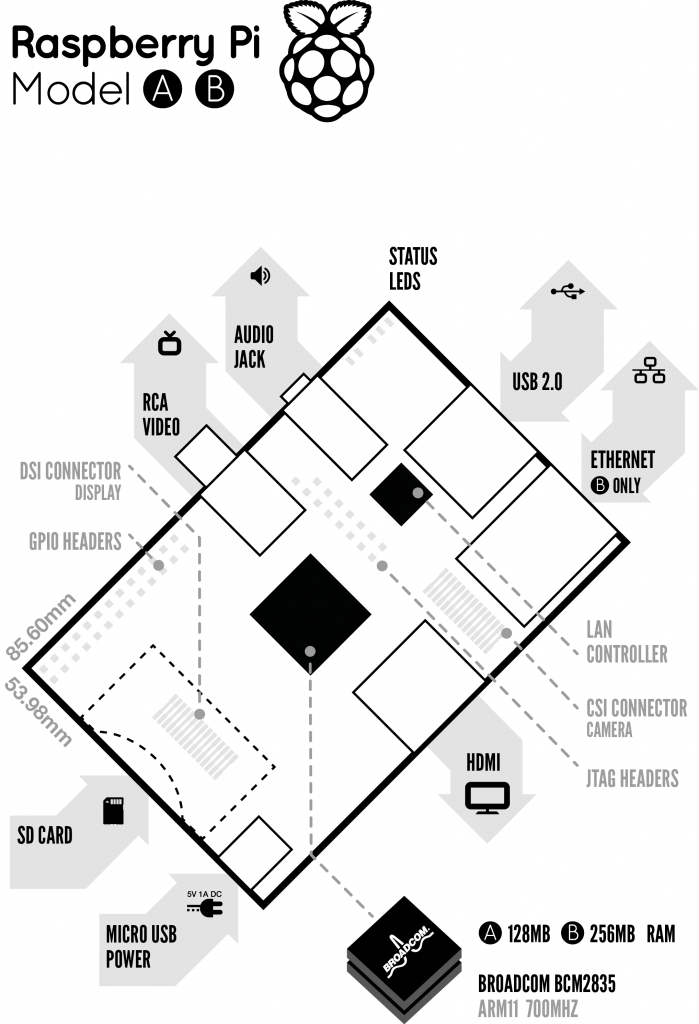Raspberry Pi: Difference between revisions
Jump to navigation
Jump to search
No edit summary |
No edit summary |
||
| Line 11: | Line 11: | ||
| memory = 256 MB | | memory = 256 MB | ||
| connectivity = USB 2, composite video, HDMI, SD card slot, 3.5 mm audio, 10/100 ethernet<ref name="ethernet" />, GPIO<ref name="GPIO" /> | | connectivity = USB 2, composite video, HDMI, SD card slot, 3.5 mm audio, 10/100 ethernet<ref name="ethernet" />, GPIO<ref name="GPIO" /> | ||
| os = [[OpenELEC]], [[Raspbmc]], [[ | | os = [[OpenELEC]], [[Raspbmc]], [[XBBian]], Debian GNU/Linux, Fedora, Arch Linux | ||
| website = http://raspberrypi.org | | website = http://raspberrypi.org | ||
}}[[File:Raspi-Model-AB-Mono-1.png|right|300px|border]] | }}[[File:Raspi-Model-AB-Mono-1.png|right|300px|border]] | ||
| Line 30: | Line 30: | ||
** [http://www.raspbmc.com/wiki/user/windows-installation/ Installing via Windows] | ** [http://www.raspbmc.com/wiki/user/windows-installation/ Installing via Windows] | ||
** [http://www.raspbmc.com/wiki/user/os-x-linux-installation/ Installing via Mac OS X or Linux] | ** [http://www.raspbmc.com/wiki/user/os-x-linux-installation/ Installing via Mac OS X or Linux] | ||
*'''[[ | *'''[[XBBian]]''' - http://xbian.org | ||
==Specifications== | ==Specifications== | ||
| Line 85: | Line 85: | ||
|- | |- | ||
| Supported operating systems: | | Supported operating systems: | ||
| colspan="2" | '''[[OpenELEC]]''', '''[[Raspbmc]]''', '''[[ | | colspan="2" | '''[[OpenELEC]]''', '''[[Raspbmc]]''', '''[[XBBian]]''', Debian GNU/Linux, Fedora, Arch Linux, RISC OS | ||
|} | |} | ||
Revision as of 10:37, 15 August 2012
The Raspberry Pi is a single-board computer developed in the UK by the Raspberry Pi Foundation.
The design is based around a Broadcom BCM2835 SoC, which includes an ARM1176JZF-S 700 MHz processor, VideoCore IV GPU, and 256 MB of RAM. The design does not include internal storage, instead relying on an SD card for booting and long-term storage.
XBMC for Raspberry Pi
Team-XBMC developers are working on porting XBMC to the Raspberry Pi using beta boards supplied by the RPi Foundation.
- Raspberrypi.org- XBMC running on Raspberry Pi
- YouTube video of XBMC running on Raspberry Pi
- XBMC.org forum thread on RPi
Installing XBMC
- OpenELEC - XBMC-centric linux-based OS install - Installing OpenELEC on Raspberry Pi
- Raspbmc - XBMC-centric linux-based OS install - http://www.raspbmc.com/2012/05/raspbmc-is-now-in-beta/
- XBBian - http://xbian.org
Specifications
| Model A | Model B | |
|---|---|---|
| Target price: | USD $25 (GBP £16) | USD $35 (GBP £22) |
| SoC: | Broadcom BCM2835 (CPU + GPU + DSP + SDRAM) | |
| CPU: | 700 MHz ARM1176JZF-S core (ARM11 family) | |
| GPU: | Broadcom VideoCore IV, OpenGL ES 2.0, 1080p30 h.264/MPEG-4 AVC high-profile decoder | |
| Memory (SDRAM): | 256 MB (shared with GPU) | |
| USB 2.0 ports: | 1 | 2 (via integrated USB hub) |
| Video outputs: | Composite RCA (PAL & NTSC), HDMI (rev 1.3 & 1.4), raw LCD Panels via DSI, 14 HDMI resolutions from 640×350 to 1920×1200 plus various PAL and NTSC standards. | |
| Audio outputs: | 3.5 mm jack, HDMI | |
| Onboard storage: | SD / MMC / SDIO card slot | |
| Onboard network: | None[1] | 10/100 Ethernet |
| Low-level peripherals: | 8 x GPIO[2], UART, I²C bus, SPI bus with two chip selects, +3.3 V, +5 V, Ground | |
| Power ratings: | 500 mA (2.5 W) | 700 mA (3.5 W) |
| Power source: | 5 volt via MicroUSB or optional GPIO header[2] | |
| Size: | 85.60 × 53.98 mm (3.370 × 2.125 in) | |
| Supported operating systems: | OpenELEC, Raspbmc, XBBian, Debian GNU/Linux, Fedora, Arch Linux, RISC OS | |
Notes
- ↑ Though the Model A doesn't have an RJ45 Ethernet port, it can connect to a network by using a user supplied USB Ethernet or Wi-Fi adapter.
- ↑ 2.0 2.1 The 26-pin GPIO connector is not assembled on the board. The end-user must purchase and solder a 13x2 pin header with 0.1-inch (2.54mm) spacing. The pin header can be either a straight pin header, mounted on either the bottom or the top, (to connect to a "daughterboard") or it can be a right-angle shrouded box connector for use with a ribbon cable.
